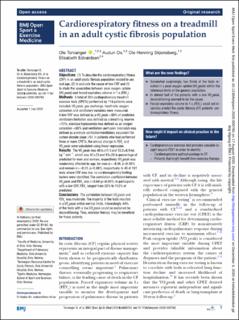| dc.contributor.author | Torvanger, Ole | |
| dc.contributor.author | Os, Audun | |
| dc.contributor.author | Skjønsberg, Ole Henning | |
| dc.contributor.author | Edvardsen, Elisabeth | |
| dc.date.accessioned | 2021-03-04T15:27:54Z | |
| dc.date.available | 2021-03-04T15:27:54Z | |
| dc.date.created | 2020-12-01T15:29:12Z | |
| dc.date.issued | 2020 | |
| dc.identifier.citation | BMJ Open Sport & Exercise Medicine. 2020, 6(1), Artikkel e000765. | en_US |
| dc.identifier.issn | 2055-7647 | |
| dc.identifier.uri | https://hdl.handle.net/11250/2731729 | |
| dc.description | This is an open access article distributed in accordance with the Creative Commons Attribution Non Commercial (CC BY-NC 4.0) license, which permits others to distribute, remix, adapt, build upon this work non-commercially, and license their derivative works on different terms, provided the original work is properly cited, appropriate credit is given, any changes made indicated, and the use is non-commercial. | en_US |
| dc.description.abstract | Objectives: (1) To describe the cardiorespiratory fitness (CRF) in an adult cystic fibrosis population related to sex and age, (2) to evaluate the cause of low CRF and (3) to study the association between peak oxygen uptake (VO2peak) and forced expiratory volume in 1 s (FEV1).
Methods: A total of 204 cardiopulmonary treadmill exercise tests (CPETs) performed by 116 patients were included. VO2peak, gas exchange, heart rate, oxygen saturation and ventilatory variables were measured.
A low CRF was defined as a VO2peak <80% of predicted, ventilatory limitation was defined as a breathing reserve <15%, exercise hypoxaemia was defined as an oxygen saturation <88% and ventilation-perfusion mismatch was defined as a minute ventilation/ventilatory equivalent for carbon dioxide slope ≥34. In patients who had performed three or more CPETs, the annual change in FEV1 and VO2peak were calculated using linear regression.
Results: The VO2peak was 40.6±11.5 and 35.2±8.9 mL kg−1 min−1, which was 87±23 and 93±20 in percentage of predicted for men and women, respectively. VO2peak was moderately affected by age, for men (r=−0.36, p<0.001) and women (r=−0.53, p<0.001), respectively. In 45 of 101 tests where CRF was low, no cardiorespiratory limiting factors were identified. The correlation coefficient between VO2peak and FEV1 was r=0.64 (p<0.001). In participants with a low CRF, FEV1 ranged from 20% to 112% of predicted.
Conclusions: The correlation between VO2peak and FEV1 was moderate. The majority of the tests resulted in a VO2peak within normal limits. Interestingly, 44% of the tests with a low VO2peak could be explained by deconditioning. Thus, exercise therapy may be beneficial for these patients. | en_US |
| dc.language.iso | eng | en_US |
| dc.subject | exercise testing | en_US |
| dc.subject | physiology | en_US |
| dc.subject | pulmonary | en_US |
| dc.subject | respiratory | en_US |
| dc.title | Cardiorespiratory fitness on a treadmill in an adult cystic fibrosis population | en_US |
| dc.type | Peer reviewed | en_US |
| dc.type | Journal article | en_US |
| dc.description.version | publishedVersion | en_US |
| dc.rights.holder | © Author(s) (or their employer(s)) 2020 | en_US |
| dc.source.pagenumber | 7 | en_US |
| dc.source.volume | 6 | en_US |
| dc.source.journal | BMJ Open Sport & Exercise Medicine | en_US |
| dc.source.issue | 1 | en_US |
| dc.identifier.doi | 10.1136/bmjsem-2020-000765 | |
| dc.identifier.cristin | 1854931 | |
| dc.description.localcode | Institutt for idrettsmedisinske fag / Department of Sports Medicine | en_US |
| dc.source.articlenumber | e000765 | en_US |
| cristin.ispublished | true | |
| cristin.fulltext | original | |
| cristin.qualitycode | 1 | |
